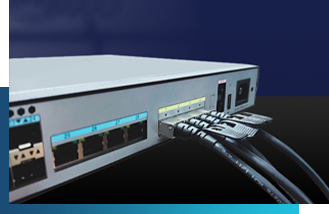
100G QSFP28 transceivers are hot-pluggable modules used for 100 Gigabit Ethernet (100GbE) data transmission over fiber optic cables. They are commonly used in data centers, high-performance computing clusters, and carrier networks.
There are several different types of 100G QSFP28 transceivers, each with its own advantages and disadvantages. Here are some of the most common types:
100G-SR4: This type of transceiver is used for short-range connections up to 100 meters over multimode fiber. It is the most cost-effective option for short-range applications.
100G-LR4: This type of transceiver is used for long-range connections up to 10 kilometers over single-mode fiber. It is a good choice for data center interconnect (DCI) applications.
100G-ER4: This type of transceiver is used for extended-range connections up to 40 kilometers over single-mode fiber. It is the best option for long-distance DCI applications.
100G-CWDM4: This type of transceiver uses coarse wavelength division multiplexing (CWDM) to multiplex four 25Gb/s signals onto different wavelengths, enabling 100GbE transmission over a single fiber. This is a good option for high-density applications where fiber counts are limited.
Choosing the right 100G QSFP28 transceiver requires careful consideration of several factors to ensure optimal performance and compatibility within your network:
Short Range (up to 100m): 100G-SR4 transceivers are ideal for intra-datacenter connections using multimode fiber. They are cost-effective but limited in reach.
Medium Range (up to 2km): 100G-PSM4 transceivers are suitable for medium distances over single-mode fiber. They offer a balance between cost and reach.
Long Range (up to 10km): 100G-LR4 transceivers are designed for longer distances using single-mode fiber. They are a good choice for data center interconnect (DCI) applications.
Extended Range (up to 40km): 100G-ER4 transceivers extend reach even further over single-mode fiber, ideal for long-distance DCI requirements.
Multimode Fiber: Suitable for short-range connections within data centers due to lower cost and ease of use.
Single-mode Fiber: Offers longer reach and higher bandwidth for longer distances between buildings or campuses.
Switch and Router Compatibility: Ensure the transceiver is compatible with your specific network devices and switch ports. Consult compatibility lists or contact the manufacturer.
Form Factor: QSFP-28 is the standard form factor, but newer options like OSFP might be relevant depending on your equipment.
Cost: Prices vary depending on type, reach, and brand. Consider striking a balance between cost and features.
Power Consumption: High-density environments might require low-power transceivers for thermal management.
Management Features: Some offer Digital Optical Monitoring (DOM) for real-time performance insights.
Vendor Reputation and Warranty: Opt for reputable brands with reliable products and suitable warranties.
Beyond these core aspects, tailor your choice based on specific use cases:
Data Center: Prioritize cost-effective options like SR4 for short links within racks or low-power PSM4 for longer runs.
DCI: Focus on reach with LR4 or ER4, potentially using CWDM4 if existing infrastructure supports it.
High-Performance Computing: Prioritize low latency and compatibility with your HPC equipment.
100G QSFP28 transceivers offer significant speed improvement over previous generations, making them valuable tools across various industries. Here's a breakdown of their key applications:
Intra-datacenter connections: Linking switches, servers, and storage devices within a data center. SR4 transceivers are popular for short intra-rack connections, while PSM4 can cover longer distances within the facility.
High-performance computing (HPC): Interconnecting HPC clusters for parallel processing tasks demands high bandwidth. 100G QSFP28 transceivers ensure efficient data movement, crucial for scientific simulations and modeling.
Cloud computing: Building high-speed connections within and between cloud data centers, enabling efficient workload distribution and resource sharing. LR4 and CWDM4 are suitable for longer DCI links.
Metro and access network upgrades: Modernizing metro and access networks to handle growing mobile backhaul and broadband internet access demands. LR4 and ER4 transceivers can support longer distances in carrier networks.
5G rollouts: Facilitating high bandwidth and low latency requirements of 5G mobile networks, enabling faster and more reliable mobile experiences.
Network backbone upgrades: Upgrading enterprise network backbones for bandwidth-intensive applications like video conferencing, collaboration tools, and large file transfers. 100G QSFP28 transceivers provide the needed speed and capacity.
Campus network connections: Connecting buildings and campuses within an organization's network with high-speed links, improving collaboration and data sharing across offices.
Research and education networks: Facilitating high-speed data transfer for scientific collaborations and data analysis in research and education institutions.
Financial institutions: Supporting demanding transaction processing needs with high-speed and reliable data connectivity.
Healthcare networks: Enabling fast and reliable data access for medical imaging and patient records, improving healthcare delivery efficiency.
Manufacturing and automation: Supporting real-time data communication and control in industrial applications, ensuring smooth and efficient operations.
The optimal application for 100G QSFP28 transceivers depends on your specific needs. Consider factors like:
Transmission distance: Match the transceiver's reach (SR4, PSM4, LR4, or ER4) to your link lengths.
Fiber type: Ensure compatibility with your network's multimode or single-mode fiber.
Cost and power consumption: Balance these factors with performance requirements.
Specific use case: Tailor your choice based on HPC, DCI, cloud, or other application needs.
